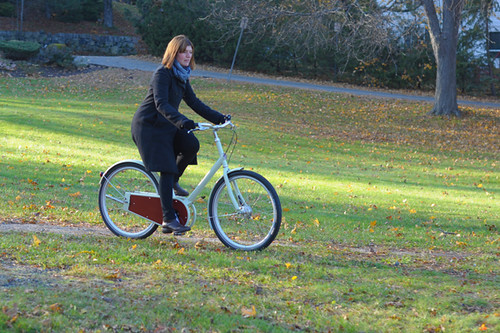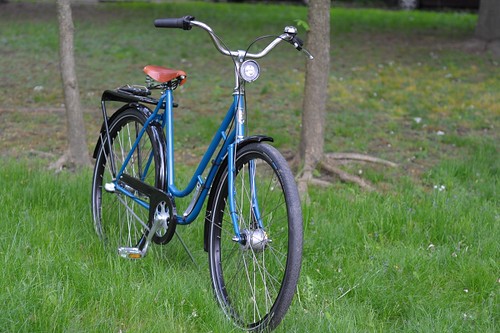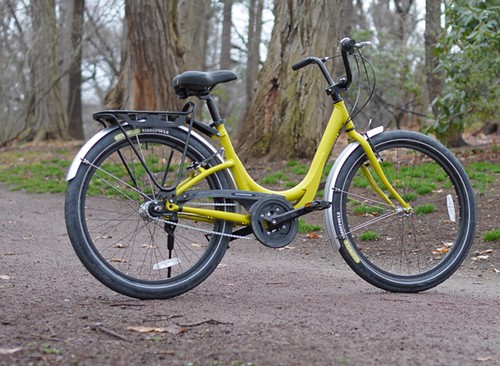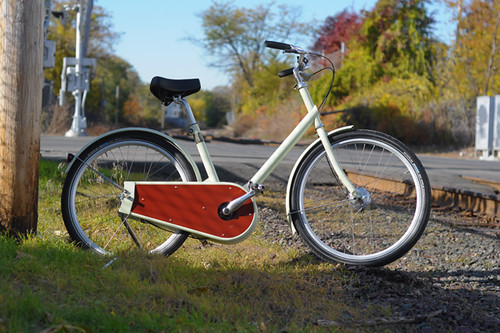A distinct category of transportation bicycles that has emerged in parallel to the contemporary classic Dutch bikes and English roadsters, is the city bike with mountain bike heritage. I have tried four distinct bicycles from this genre so far: the Retrovelo, the Urbana, the Pilen, and the Paper Bicycle.
The lugged Retrovelo is the most deceptively traditional looking of the bunch. But behind the facade of an elegant European city bicycle, it is essentially a remake of an early mountain bike design - made speedier with the fast rolling Schwalbe Fat Frank tires (originally made for Retrovelo and named after its designer Frank Patitz). When I rode a Retrovelo for the first time, I noticed that its handling felt different from that of Dutch city bikes and English roadsters, but could not articulate how or why. Having now tried other bicycles with MTB roots, it makes more sense.
The swan-framed Pilen surprised me with an even more dramatic difference in handling from traditional European city bikes. Its "unfellability" reminded me of one of those roly-poly toys that stay upright no matter how far you try to push them to the side. It was on the Pilen that I overcame my dislike of cycling on grassy hills and rock-strewn trails. And with its Schwalbe Big Apples in 700C, it towered over other bikes in city traffic while also breezily rolling over rough terrain.
Pushing the limits of my aesthetic open-mindedness, the Urbana is basically a downhill mountain bike redesigned with a low step-over U-frame, fitted with BMX handlebars, and equipped with all the contraptions necessary for transportational cycling - including a rear rack that, together with the frame design, allows the bike to carry an insane amount of weight without impacting handling. Unabashedly industrial looking, the Urbana does not aim at classic prettiness. But it sure rides well - rolling over substantial road debris and hopping curbs on its 2.6" wide tires with monster-truck ease and city bike grace.
And then there is the Paper Bicycle. With its seemingly bizarre construction, this bike manages to combine an upright sitting position with the type of "bad ass" mountain-bikey handling that inspired me to actually try riding it down a steep rocky hill (successfully). On top of that, it is responsive enough to ride long distance, as a single speed.
Knowing fairly little about mountain bike design (other than that they have a "low center of gravity" - which means what, exactly, as far as frame construction goes?..), I am not in a position to offer a technical analysis of these bicycles. But as a cyclist who has tried a myriad of city bikes at this point, I can feel a common thread in their handling. Granted, "stability" is a vague term. But theirs is a distinct brand of stability that I for one find useful in a city bike. The same qualities that make these bicycles stable off-road, are what makes them unexpectedly reassuring in traffic, indifferent to crater-sized potholes, and immune to unexpected road debris. There is more to it, but alas, I lack the vocabulary to describe it.
While mountain bikes have been used for transportation for decades, their sluggish tires, bouncy suspension forks, derailleur gearing and lack of fenders made them sub-optimal for this purpose. Also, allow me to be honest: Contemporary mountain bikes are rather ugly. But harvesting their best characteristics while optimising them for urban transport and aiming for a more classic look, seems like an excellent recipe for a fun, reliable and versatile city bike.










0 comments:
Post a Comment